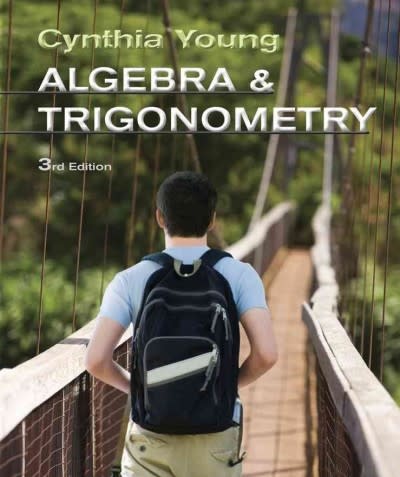Question
An informational collection containing 70 perceptions, each answered to one decimal spot, is to be part into seven classifications. The biggest perception is 75.1, and
An informational collection containing 70 perceptions, each answered to one decimal spot, is to be part into seven classifications. The biggest perception is 75.1, and the littlest is 16.3.
(a) These information are covered by a time frame length?
(b) Utilizing the strategy laid out in this part, every class will be of what length? (c) What is the lower limit for the principal classification? (d) What are the limits for every one of the seven classes?
Question 42
(Quartiles.) The 25th, 50th, 75th, and 100th percentiles for X are called its first, second, third, and fourth quartiles, separately.
(a) Express the meaning of the first quartile in quite a while of probabilities. (b) Let X be binomial with n = 20 and p = .5. Track down the primary quartile for X. (c) Let X be dramatically conveyed with p = 1. Track down the primary quartile for X
Question 43
The percentiles, quartiles, and deciles for a constant arbitrary variable can be approximated from a general total recurrence ogive utilizing the projective technique. For example, in Fig. 6.5 we approximated the 50th percentile for X, the life expectancy of a lithium battery, to be barely 725 hours.
(a) Rough the principal quartile for X. the cadmium level noticeable all around, utilizing the information of Activity 8.
(b) Estimated the fourth decile for X, the quantity of gallons of fluid item got per ton of coal fuel, utilizing the information of Activity 10.
(c) Estimated the 50th percentile for X, the rate debris content for a specific assortment of greenery, utilizing the information of Activity 11.
FIGURE 6.5 Histogram delivered through MINITAB default settings.
40
30
u 20
10
0
I - 250 750 1250 1750 2250 2750 3250 3750 4250 4750
Hours
Question 44
There have been numerous upgrades made in lighting over the most recent 10 years. One new bulb, the Philips' Earth Light, utilizes a smaller screw-in bright light bulb with an electronic stabilizer fused in its base. It is thought to last 10 to multiple times longer than family bulbs utilized previously. These information are gotten on the life expectancy of an example of these new bulbs (time is in huge number of hours):
9.1 10.1 9.0 11.4 10.5 9.5 12.0 9.1 12.2 13.1 10.0 9.3 9.0 9.6 11.1 9.1 13.3 10.7 9.1 9.0 11.0 9.2 11.6
(In view of data found in "Lighting Grows up with New Innovation," Innovative work, November 1992, pp. 30-31.)
(a) Develop a stem-and-leaf outline for these information, and recommend a circulation from which these information may have been drawn.
(b) In view of these information, estimated the estimation of p, the normal life expectancy of these bulbs. (c) Surmised the middle life expectancy of these bulbs, and clarify precisely what this worth methods. (d) Discover the example change and test standard deviation for these information.
(e) Reprimand the accompanying assertion: - In view of the typical likelihood rule, it is assessed that around 95% of all bulbs have a life expectancy somewhere in the range of 7,530 and 13,050 hours.-
(f) In view of Chebyshev's disparity, the thing can be said about the extent of bulbs whose life expectancy is required to fall somewhere in the range of 7,530 and 13,050 hours?
Step by Step Solution
There are 3 Steps involved in it
Step: 1

Get Instant Access to Expert-Tailored Solutions
See step-by-step solutions with expert insights and AI powered tools for academic success
Step: 2

Step: 3

Ace Your Homework with AI
Get the answers you need in no time with our AI-driven, step-by-step assistance
Get Started


